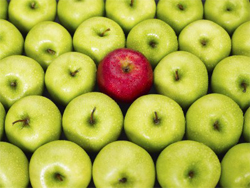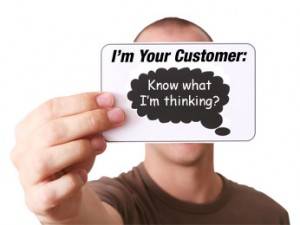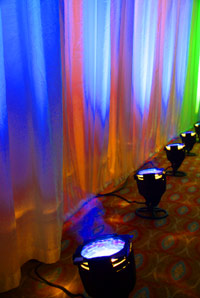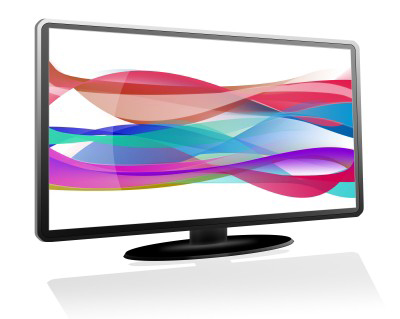Top Tactics to Make Your Trade Show Booth Stand Out
Every industry has its norms. At a medical industry show, the show floor will resemble a tranquil sea of blues and whites, colors that convey cleanliness and reliability. At technology industry shows you’ll see lots of bright colors, bold graphics and eye-popping presentations on flat-screen monitors. While every industry has its norm, the reality is that in order to make your booth get noticed by attendees, the last thing you want to do is to blend in with competing booths.
 So how do you differentiate your exhibit so attendees will be captivated long enough for your booth staff to engage them and deliver your company’s marketing message? In order to successfully achieve your company’s trade show objectives, whether that is generating sales leads or educating a new market about your products or services, the first step is to garner the attention of prospective customers.
So how do you differentiate your exhibit so attendees will be captivated long enough for your booth staff to engage them and deliver your company’s marketing message? In order to successfully achieve your company’s trade show objectives, whether that is generating sales leads or educating a new market about your products or services, the first step is to garner the attention of prospective customers.
Many companies exhibiting at trade shows make the classic mistake of trying to fit in with other exhibitors. Perhaps it’s your company’s first foray into a particular market or event. You want your company to look like it can play in the same sandbox with other big players in the market. The problem is fitting in isn’t going to help your company stand out amidst its competitors.
Here are a few ways in which you can differentiate your company’s exhibit:
Color: Avoid the standard color palette of the industry. Choosing a unique color scheme for your booth is a simple way to visually set your booth apart from other booths. Be careful, however, and do your research before picking a color scheme. Different colors convey certain messages that might not align with your trade show objectives or your marketing message.
Structure: Be creative here, and don’t settle for a standard exhibit configuration. If your competition typically uses a booth layout with formal meeting areas/rooms, go for a casual lounge feel instead. If competing booths are very geometric and angular, go for a free-flowing, airy feel with a fabric structure featuring organic shapes and soft, curvy lines.
Lighting: One way to breathe new life into an older exhibit is to enhance or change up the lighting scheme. Be creative here as well. Colored lights can add pizzazz and be a real attention-getter. Soft lighting can create a calm, intimate setting.
Product Displays: Don’t overcrowd surfaces with product displays. Again, take note of what your competitors are doing. Use creativity to highlight your products in a way your competitors aren’t. Again, the purpose is to get your booth to stand out so attendees will pause long enough to notice your products and marketing message.
Booth staff: It’s important to put together a “front line” offense when it comes to your booth staff. Don’t staff your booth with temp workers or new employees. Bring out your “big guns,” which typically means your product development folks who can speak at great length—not just about your products, but those of your competitor’s and industry pain points as well.
Trade Show Targeting – What Makes My Customer Tick?
Understanding the business concerns, issues and problems of your prospects and customers is paramount in crafting a marketing message. This message is a critical component of your trade show plan, as well as your business marketing plan as a whole. However, it is not easy to tap into their minds. This process requires market research to effectively derive their characteristics for purchasing. During the last few years, the buying patterns have changed and possibly your customer persona has evolved into a totally different person. Keeping up with the shifts and changes can be difficult.
 One way to tune into the mindset of a customer base is using focus groups. They can be quite effective in uncovering the thought processes and preferences of an audience. If you are not familiar with this research form, let me provide some additional information.
One way to tune into the mindset of a customer base is using focus groups. They can be quite effective in uncovering the thought processes and preferences of an audience. If you are not familiar with this research form, let me provide some additional information.
What are Focus Groups?
Focus Groups are great at capturing the attitudes and opinions of a “selected” group(s) of individuals. The moderator poses questions to the group affording the participants the opportunity to share their views. It is important to remember that these groups are qualitative in nature and sometimes would need to be followed up with a quantitative research project to ensure statistical reliability.
However, the catalytic nature of focus groups can provide direction as to what the next steps should be in the evolution of the idea being tested.
In essence – you are testing ideas or communication messages to determine if they are on target or not. Customer and prospect language or what they “hear” can be TOTALLY different from what you are communicating. Being in tune with your audience can spell s-u-c-c-e-s-s.
Using Online Research to Probe the Minds of Your Customer
Rather than in-person focus groups, participants are recruited for the online experience. Typically, 12 – 15 are secured and they commit to the process.
- A research moderator posts questions over the course of several days as the conversation evolves and probes respondents for details and clarifications when needed.
- Respondents can log in and answer each days’ questions whenever it’s convenient for them – some folks are online at the crack of dawn, some like to log in and take a break during work hours and others log in after dinner is done and the kids are in bed. Being convenient means that respondents can take time to think about the questions and provide thoughtful answers.
- Clients are able to log in and observe the discussion and leave private messages for the moderator regarding comments they would like clarified or suggestions for new topics.
- They last over a three-day period which allows for reflection on questions answered and possible modifications to the moderator’s script.
The participants interact with each other and the moderator as they provide their valuable insights to questions posed. In the process, all sorts of light bulbs are illuminated and most often a new, enhanced direction is revealed.
Mike Courtney from Aperio Insights shares these insights when considering online focus groups to determine your trade show messages.
Most likely there is a current marketing communications campaign going on within your company. Does your audience really understand the campaign or is there some confusion on the message you are attempting to convey?
Or you can assess whether your prospects deem you as a trustworthy resource. Or do they trust your competition more than you?
Have the prospect or customer “explain” your services or products to the moderator of the online focus group. Are they accurately defining your offering? Note: this question can be quite revealing as to how far off the mark your audience is to what your product does or what your marketing message is.
One other word of note – research can beget research. The more you uncover – additional questions will surface.
As you research and make your trade show marketing plan, consider taking the pulse of your customers. If you can translate their heartbeat (the business issues) into your marketing message, a match is made and most likely you will have a new customer.
Trade Show Strategy: Plan it Like an Expedition
I like to think about a trade show like an expedition. I’m headed off to some exotic land in search of treasure. I will be deep in the jungle, cut off from civilization for days. It will be hard to get supplies. I know that my team should expect no outside help. The fate of the entire expedition rests in the hands of the people I choose to man the booth, careful planning and how well equipped we are to meet the expected – and unforeseen – challenges.

The treasure is, of course, new customers and sales. And getting those new customers requires an action plan.
Plan your targets in advance
About 75% of show attendees plan booth visits and meetings before the show starts. Review the attendee list in advance of the show. ID your targets. Start to invite people to visit your booth a few weeks before the show. Personal phone calls are most effective and harder to ignore than e-mails and mailings. Think about pre-show communications that will create anticipation of your booth – it can feature a special promotion or some buzz about a new product release.
Make sure you and your team are outfitted for this adventure
Select clothes that look professional or that support the theme of your booth, but also make sure that everyone will look great all day. Plan on it being either too hot or too cold – attire with a jacket that can be removed is a great choice. And wear comfortable shoes. (One of the biggest mistakes I ever made was wearing beautiful, brand new shoes that were not a great fit to a trade show.) It is almost impossible to really smile if you have been standing for 6 hours and your feet hurt.
Have enough staff or find a partner
Ideally, you will have enough staff in your booth to meet with prospects and give your team breaks. If you have limited staff or have only one person at the booth for a show, find another larger company to partner with. It is best to do this before you select your booth location so that you can be located next to each other or share a larger space.
Pick the right team
Who you pick for this “expedition” is essential to making it successful. Fill your team with high-energy people who have an upbeat attitude. And make sure that everyone who is representing your company has deep product knowledge.
Plan your sales material carefully
People who attend a show are bombarded with information and the best way to be remembered is from your sales literature. Make sure it is easy to carry and packed with valuable information – your goal is to make sure people take your material back to their office. If you have a really valuable prospect, make sure to get their contact information and send material to them after the show.
Carefully select your bait
Over 90% of exhibitors bring a premium or free sample to give away at a trade show because offering an attractive free gift is great way to attract people to your booth. You will be the best choices and can usually save money if you plan this in advance.
What do you do before a show to make it more successful?
Is Your Trade Show Exhibit a Good Investment?
Many marketing executives can’t completely answer this question. They essentially repeat what was done in previous years with slight variations in execution. Taking a moment to analyze your trade show goals and results can help you find new ways to acquire more customers and make your trade show investment really pay off.
Trade shows are expensive, but they can also be one of the best sales and marketing investments your company makes. Trade show exhibits provide unparalleled opportunities to forge stronger customer relationships, win-back old customers and acquire new, high-value customers. But you should expect this effort to deliver more.
Maximizing your Trade Show Exhibit investment
- Incremental sales and profits
Track your results and determine your Trade Show ROI. More information about how to calculate your Trade Show ROI. If your trade show ROI is not acceptable, then look for ways to make improvements. First, look for gaps in sales and customer tracking to ensure that the data is accurate and complete. Next, make sure that the shows selected were good choices and had significant attendance from your target customers.
If your trade show ROI is not acceptable, then look for ways to make improvements. First, look for gaps in sales and customer tracking to ensure that the data is accurate and complete. Next, make sure that the shows selected were good choices and had significant attendance from your target customers.
Then look for marketing gaps: ineffective or no lead follow-up, insufficient planning, staffing issues or other reasons that the shows were not productive. Once you identify an issue, you can adjust your strategy and improve results.
- Improved competitive position
Did your company strengthen relationships with current customers, increase brand awareness, launch a new product that differentiated your company, expose your company and products to a new market? Generally, did your trade show investment help position your company for future sales gains and market share increase?If your trade show exhibit doesn’t improve your market position, then carefully evaluate your strategy. How can you adjust your trade show marketing plan to outdo your competition? - PR and Investor Relations
Did you generate meaningful press coverage? Did your company’s trade show presence result in improved perception of your company in the investor community? Do you get any significant consumer education opportunities from the show?If your trade show attendance has not been a PR opportunity, it is a promotional gap that should be evaluated for potential for your company. - Market intelligence
Trade shows are an excellent way to gain competitive intelligence. They also can be used for market research and provide an excellent opportunity to gain customer insight.If your trade show isn’t providing your company with market intelligence, develop a plan to maximize this unique opportunity to gather both the latest competitive info and to learn more about your customers.
Have you analyzed your trade show investment? Are you satisfied with your results?
Create Exhibits with Curb Appeal
Trade shows are by nature quite chaotic. Attendees bustling from booth to booth while exhibitors fight to garner their attention and interest in their companies’ products or services. Studies have shown that a tradeshow display typically has about three seconds to catch the attention and communicate to a potential customer passing by a booth. To makes things even harder, your booth is competing with possibly hundreds of other displays for attendees’ attention.
 So, exhibitors have a matter of seconds to grab attendees’ and potential prospects’ attention and make an immediate impression. Eye-popping, colorful graphics in tradeshow booths are an excellent way to do just that. Graphics in tradeshow booths can include booth signs, displays, banner stands, and even table cloths. So what makes one booth an attention-grabber and another one that’s easily passed by?
So, exhibitors have a matter of seconds to grab attendees’ and potential prospects’ attention and make an immediate impression. Eye-popping, colorful graphics in tradeshow booths are an excellent way to do just that. Graphics in tradeshow booths can include booth signs, displays, banner stands, and even table cloths. So what makes one booth an attention-grabber and another one that’s easily passed by?
Here are some things to think about when you set about creating the graphics that will hopefully deliver a powerful visual punch and grab the attention of potential prospects.
Pick a good color. The right color can help you both convey a message and stand out amidst the sea of competing booths. Warmer colors, such as red, orange and yellow attract more attention than cooler colors, such as blue, green and white.
Keep images simple. Simple, bold and clear images are the most effective in conveying your marketing message to attendees. The more ornate and involved the graphics, the more you risk confusing, overwhelming and distracting booth visitors. If possible, choose just one simple image.
Headlines are key. So put a lot of thought into writing them! Choose your words very carefully and keep it simple, clear and short. This might be the only shot at grabbing the attention of attendees who are giving your booth at most a passing glance. A crafty, compelling headline may be what brings them in to hear more about your company. Also the shorter the headline, the bigger it can be, increasing visibility.
Keep it light. Lighting is very important to helping draw the attention of attendees and in creating a welcoming atmosphere. Be creative with lighting; choose to spotlight a new product or use warmer lighting to create an inviting environment.
Choose a message that packs a punch. This is a tough one. You already know you have to keep it short and sweet with simple imagery. The things that you must communicate are: who you are, what your business does, and what separates you from your competition.
Theatrical Trade Show Booth Lighting
Theatrical lighting in a trade show booth can add dramatic effect to almost any display property on the show floor. Different lights and lighting effects can be used to enhance color, create a mood among attendees, focus an attendee’s view to a feature area, and create visual texture, all enhancing the attendee’s experience.
However, the budget for theatrical or moving lights can quickly escalate. That’s why, when a company sets out to build a new booth or rent a property, lighting is often the last thing considered, and even more often, the first thing cut back. So how and why should you keep lighting in your trade show budget?
Consider the basics when creating a trade show exhibit lighting package:
- What is the effect you wish to achieve?
- What is the benefit of that effect on the attendee?
- How does that relate to the attendee’s impression of your exhibit?
- What is your budget, and how much of it do you wish to allocate to the lighting package?
“HEY, LOOK AT US!”
Amid the wide expanse of the show floor, a static booth with little or no lighting easily gets lost. However, an exhibit with good lights screams, “Hey, there is something exciting over here!” The result? Attendees come to see what it’s all about. Once the attendee is near or in the booth, colored and moving lights add life to an otherwise static display. The colors and moving “textures” can create a mood of peace, elegance, or an over-all feeling of warmth that can make attendees more at ease, and more likely to stay around.
The additional benefits of trade show booth lighting are simple:
Use lighting to draw attention to areas within the booth you wish to feature. Well-positioned lighting can help your graphics and equipment “pop” amidst the yellowish-hazy hall lighting that tends to be rather drab. Full-color graphics show more color, equipment can appear even more shiny and polished, and the everyday background canvas of the booth fades even further into the background, highlighting the items you really want attendees to focus on.
 What will you need to include, and what effect will lighting have on cost? First, the overall cost of your electrical order will increase. To create the lumens required just takes more juice. You will also typically need a distribution panel to distribute the electrical. In most cases, this will go on the floor, somewhere in a dedicated space; a safe estimate of space required would be around 100 square feet. In addition to the panel, moving lights may need a lighting board (a sort of “brains,” if you will), to control the intelligent lighting. You will need a technician to program the lights and get the board up and running prior to the show. A good technician, with availability during the show, is likely to be more expensive, but is a good investment. The price may be a little higher, but peace of mind can be priceless, as any mid-show hiccups can be quickly dispelled.
What will you need to include, and what effect will lighting have on cost? First, the overall cost of your electrical order will increase. To create the lumens required just takes more juice. You will also typically need a distribution panel to distribute the electrical. In most cases, this will go on the floor, somewhere in a dedicated space; a safe estimate of space required would be around 100 square feet. In addition to the panel, moving lights may need a lighting board (a sort of “brains,” if you will), to control the intelligent lighting. You will need a technician to program the lights and get the board up and running prior to the show. A good technician, with availability during the show, is likely to be more expensive, but is a good investment. The price may be a little higher, but peace of mind can be priceless, as any mid-show hiccups can be quickly dispelled.
With a well-planned lighting package, your tradeshow ROI can increase traffic and improve attendee perception.
Trade Show Strategy: Quality Displays Matter
When you exhibit at a trade show, the quality of your display really matters to increase booth impact. A brilliant concept or a great design will fall flat if the booth is poorly designed, manufactured from inappropriate materials or poorly constructed. Smart exhibitors establish very specific quality criteria before they start to work with a design company on their booth.
 How do you define quality?
How do you define quality?
Quality can be the combination of many factors: design, durable materials, craftsmanship, use of innovative technology, low environmental impact, and so on. Quality is based on your needs, your company’s or organization’s goals and your target customers’ values.
Here are a few things to consider when you develop your exhibit quality criteria.
- Quality Graphic Design
Great graphic design is critical if you want to present your company in the proper light. No matter how much you spend on booth production and construction, if the graphic design is not first-rate, it will not matter. - Specify Quality, High-impact Materials
You may not be able to specify exact materials for your exhibit but you can require that the materials used are high-impact materials that are suitable for the handling, wear and tear you expect for the exhibit. - Review Sample Work to Evaluate Potential Firms
Look at samples of design firms’ work to evaluate each firm’s production quality and attention to detail. - Everything in the Exhibit Deserves Consideration
The quality standards should apply to every part of your exhibit: displays, sales collateral, premiums, even the exhibit staff’s apparel. - Structural Integrity
If your booth exhibit incorporates large, constructed elements, make sure that they are properly engineered to eliminate any risk of structural failure. - Installation and Takedown
Poorly managed installation and dismantling can undermine every investment in quality you make. Make sure you have a professional managing both installation and takedown. - Quality Packing and Shipping
If your exhibit is poorly packed, it is more likely to be damaged in transit. Think about including quality crates or cases in your budget. With proper packaging, your booth will be properly protected when shipped and you many actually save money in the long run by reducing operating labor costs.
Why You Should Replace Traditional Graphics With Flat Screen Displays
Situation: You are getting ready to exhibit at your most important show of the year. You pull your exhibit out of the warehouse and realize that the graphics and entire exhibit looks outdated and tired. You need to update, but your budget is limited. You can’t afford to replace your entire trade show booth – you can’t afford to fade into the background at this show.

One Solution: Replace your exhibit graphics with flat screen display monitors and a media player.
There are many ways to update and refresh an outdated trade show exhibit. Increase booth impact by replacing graphics with digital displays will add a high-impact look to your display and help bring it up to speed with newer, more high-tech exhibit properties.
Converting your graphics to flat screen digital displays can involve greater up-front costs than just replacing the graphic panels, but you will be building longevity and flexibility into your exhibit. Plus, adding digital display monitors has other benefits:
- You may be able to save on graphics production unless you create very elaborate digital presentations.
- You can create attractive dynamic signage that will attract attention and draw more people into your booth.
- You can quickly update your messaging by creating new content.
- You can affordably adjust your brand presentation and featured products for each show’s specific market.
- You can create presentations that will help customers visualize what you can do for them.
Updating your trade show booth with digital display monitors and a dynamic presentation can help you attract trade show attendees and encourage more of them to buy your products or services.
Need help with updating your trade show display? We can help. Let’s talk.
Putting your Best Face Forward: How to Staff your Trade Show Booth
You can spend lots of money creating an eye-grabbing, elaborate trade show exhibit, but lose potential customers if your booth personnel are not well trained and prepared. Make it an essential part of your pre-show strategy, right along with pre-event marketing and demo preparations. Keep in mind that these people will leave a lasting impression, good or bad, on your attendees and potential customers when they leave your booth, so pick the best and brightest to represent your organization.
Here are a few more tips on how you can ensure that everyone in your trade show staff is show-ready:
Make sure they are well versed. This is particularly important when using temp workers. These people need to know detailed background about your company, its mission, goal, target audience, products or services, as well as your sales and marketing message.
Practice makes perfect. Establish a pre-show training session and conduct them before every show. Prepare a list of objectives and make sure everyone is aware of their role. For example, some people might be assigned official greeters, while others might be reserved for fielding more detailed technical questions.
 Choose friendly folk. This might seem obvious, but the more outgoing and friendly a person is, the better they will be at engaging prospects.
Choose friendly folk. This might seem obvious, but the more outgoing and friendly a person is, the better they will be at engaging prospects.
Stick to the script. Training booth personnel should include a well-practiced script that includes a quick introduction of themselves, a one-minute overview of your company and its products; a few questions to qualify the attendee as a potential prospect; and a request for contact info for effective follow-up after the event.
Dress the part. Make sure that booth staff understands what is expected of them in terms of how to dress, proper etiquette (no gum chewing, eating, etc.), the importance of arriving early and being prepared, and how long they are expected to be on duty.
Don’t overstaff. It’s human nature to avoid excessively crowded spaces and nothing is more intimidating then walking into a booth and being besieged by a throng of over-eager salespeople. Proper staffing will depend upon the size of the actual booth.
Put sales staff on the front line. Even if you rely on temporary help at trade shows, it’s vital to have salespeople in the mix and preferably taking the lead in greeting visitors and doing demos.
Listen more, talk less. Companies can learn more about potential customers and how they might be able to help them by taking the time to listen to their needs, pain points, issues, etc. Booth staff should adhere to the 80/20 principle: listen 80% and talk only 20%.
Tradeshow Booth Staffing Tips
Hiring tradeshow talent and booth staff can provide an exhibitor much better returns on investment than in years past, providing that one understands the need, and seeks the most qualified candidate(s) to fill that need.
Pre-Qualify Prospects: Trade Show Talent Acts as an Ambassador for Your Booth
Browse the internet for convention and tradeshow models, and you’ll find that there are hundreds of agencies providing this type of service. With so much to choose from, where to begin? First, prioritize your needs as an exhibitor. The early days of car show models & booth babes have expanded into tradeshow talent that can not only greet attendees but also demonstrate products and engage attendees in conversation. When considering hiring staff, be sure to consider what the role of this hired talent will be.
When Hiring Talent for your Tradeshow Booth, Find a Reputable Agency
 If you expect superior communication skills, good eye contact, and a witty personality, then you shouldn’t just go online and start looking for price quotes. You’ll want to start by finding a reputable agency, preferably one recommended by a display house, that has numerous testimonials and references. Furthermore, you will want to outline, in writing, precisely what you will expect from your hired tradeshow staff. They are, after all, an extension of your sales staff, as the CMT agency states on it’s website “More important than just being attractive, they know and exemplify the fact that being outgoing, friendly, engaging and professional are what matter most on the tradeshow floor.”
If you expect superior communication skills, good eye contact, and a witty personality, then you shouldn’t just go online and start looking for price quotes. You’ll want to start by finding a reputable agency, preferably one recommended by a display house, that has numerous testimonials and references. Furthermore, you will want to outline, in writing, precisely what you will expect from your hired tradeshow staff. They are, after all, an extension of your sales staff, as the CMT agency states on it’s website “More important than just being attractive, they know and exemplify the fact that being outgoing, friendly, engaging and professional are what matter most on the tradeshow floor.”
Base your search for hired staff on your written outline of criteria. Speak to the agency about the qualifications and experience of each booth model. Ask the agency the tough questions, don’t be afraid to shop around. You will find that some agencies book superior talent, far beyond what might be considered standard or acceptable, including interpreters, product presenters, costume characters or entertainers. Find some talent with more than just a pretty smile. You might find that a well-qualified presenter just happens to be available during your show days, and needs the work. Why settle for a bikini model when you can have an excellent ambassador in your booth?
Include Tradeshow Booth Talent in Your Booth Staff Training
Before the show, outline a plan for your hired staffers. Share it with them well in advance so they may ask questions and get clarification. Expect them to show up well before the show starts each day, and have a briefing about expectations and or goals. INCLUDE THEM IN YOUR BOOTH STAFF TRAINING! You will want to emphasize the importance of pre-qualifying prospects, a major part of booth staff training. At the end of the day, have a wrap-up meeting, and again, include them with your staff. You are, after all, paying a premium – so why not demand a little more? If you make your staffing choices well, you can not only increase traffic and lead generation, you will also ratchet up tradeshow ROI.
Archives
- July 2021
- June 2021
- May 2021
- April 2021
- October 2018
- September 2018
- August 2018
- July 2018
- June 2018
- May 2018
- April 2018
- March 2018
- February 2018
- January 2018
- December 2017
- November 2017
- October 2017
- September 2017
- August 2017
- July 2017
- June 2017
- May 2017
- April 2017
- March 2017
- February 2017
- January 2017
- December 2016
- November 2016
- October 2016
- September 2016
- August 2016
- July 2016
- June 2016
- May 2016
- April 2016
- March 2016
